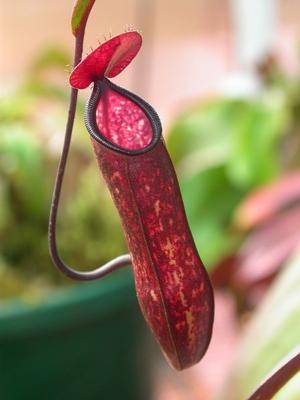Sun, Jan 05, 2014
Substance Could Prevent Ice From Adhering To Surfaces During Flight
A tropical carnivorous plant – the pitcher plant – which traps its prey inside its body with a virtually frictionless surface is inspiring a new generation of coatings capable of repelling liquids including blood, oil, honey and even ice on aircraft.

Nature is well-known for its ability to repel liquids with lotus leaves, rice leaves, butterfly wings, mosquito compound eyes, cicada wings, red rose petals, gecko feet, desert beetles, and spider silk all having the ability to remain dry. However, the pitcher plant or Nepenthes, which is found in countries including Australia, Malaysia and Madagascar, has a special adaptation which creates a near frictionless surface with unique self-healing properties.
The ability to repel liquids and contaminants has important applications to industry and everyday life. Coatings are needed to help stop the formation of life-threatening bacteria on medical instruments, ice build-up on aircraft, fouling on ship hulls, anti-corrosion and the efficient transportation of products like crude oil by pipeline.
The pitcher plant is different to some other nature-inspired adaptations by ‘locking-in’ a lubricant layer onto the surface of its skin which cannot be penetrated by another liquid and is more damage tolerant. The result is also fatal to the plant’s prey – insects and small frogs – which are unable to climb out of its smooth, deep, tubular-shaped body. A team at Harvard University have now been able to mimic the pitcher plant’s inner skin design to produce a transparent coating capable of being economically applied to almost any object – large or small.
The multi-stage coating process involves attaching a thin, but rough layer of porous silica particles which are used to lock-in a lubricating layer onto the surface to be protected. Its diverse applications could include acting as an anti-graffiti coating on walls or on medical implants to aid blood flow.
This latest development in coating technology reached the finals of this year’s Institution of Chemical Engineers (IChemE) Awards in the UK, which recognizes excellence and innovation in the chemical and process industries worldwide. “Some existing coatings have limitations including contamination and degradation by contaminants, lack of self-healing capabilities and damage tolerance," said IChemE’s chief executive, Dr David Brown. “By mimicking the pitcher plants skin structure, Harvard University’s new coating self-heals almost instantly, even if scraped with a knife or blade. It is capable of operating in extreme temperatures and high pressure, and can be applied to surfaces ranging from metals and semiconductors, to paper and cotton fabric.
“It is a very clever solution by the team at Harvard University and another excellent example of how chemical engineering is being used to improve the features and performance of products we need and rely upon every day.”
(Public domain image via Wikipedia)
More News
Terminal Radar Service Area Airspace surrounding designated airports wherein ATC provides radar vectoring, sequencing, and separation on a full-time basis for all IFR and participa>[...]
Very High Frequency (VHF) The frequency band between 30 and 300 MHz. Portions of this band, 108 to 118 MHz, are used for certain NAVAIDs; 118 to 136 MHz are used for civil air/grou>[...]
“From approximately November 2021 through January 2022, Britton-Harr, acting on behalf of AeroVanti, entered into lease-purchase agreements for five Piaggio-manufactured airc>[...]
Also: Virtual FLRAA Prototype, IFR-Capable Autonomous A/C, NS-32 Crew, Golden Dome Missile Defense Bombardier announced that the first production Global 8000 successfully completed>[...]
Aero Linx: The 1-26 Association (Schweizer) The Association’s goal is to foster the helpfulness, the camaraderie, and the opportunity for head-to-head competition that is fou>[...]
 ANN's Daily Aero-Term (05.29.25): Terminal Radar Service Area
ANN's Daily Aero-Term (05.29.25): Terminal Radar Service Area ANN's Daily Aero-Term (05.30.25): Very High Frequency (VHF)
ANN's Daily Aero-Term (05.30.25): Very High Frequency (VHF) Aero-News: Quote of the Day (05.30.25)
Aero-News: Quote of the Day (05.30.25) Airborne 05.23.25: Global 8000, Qatar B747 Accepted, Aviation Merit Badge
Airborne 05.23.25: Global 8000, Qatar B747 Accepted, Aviation Merit Badge ANN's Daily Aero-Linx (05.30.25)
ANN's Daily Aero-Linx (05.30.25)



